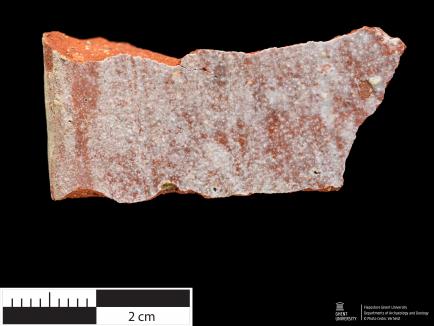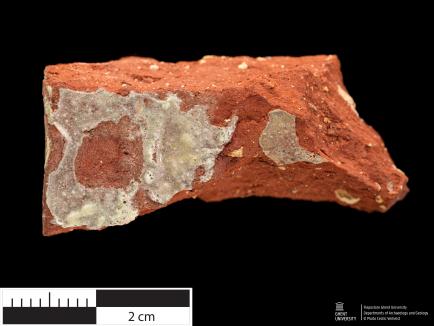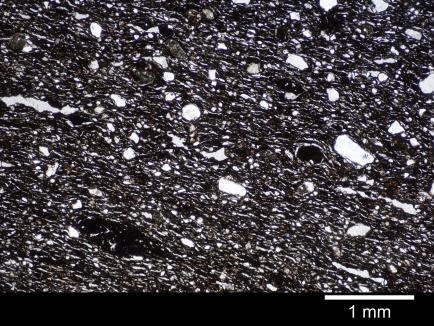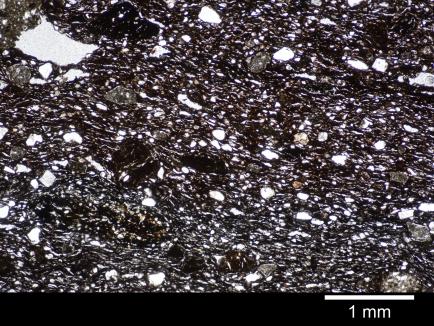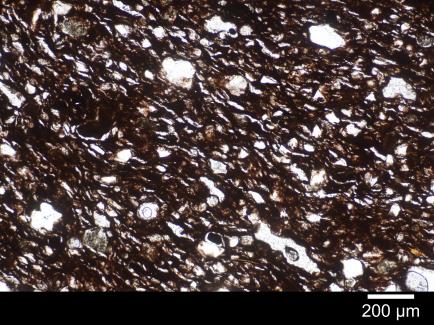Post Medieval - Ceramic building material (7.CBM.BE.0001)
Hand specimen pictures (macro & binocular)
Thin section pictures
Find location
- Category
- Ceramic building material (Post Medieval)
- Fabric name
- Chronology
- Post Medieval > Modern > 1750-1800
- Dating method(-s)
- morphology, historical sources
- Potters' mark
- No
- Additional information
- saggar rim fragment (ovenkoker rand fragment); used in the firing process of faience/majolica
Find location
- Site type
- Pottery production
- Location
- Belgium; West-Vlaanderen; Brugge
- Site name
- Brugge, Arsenaalstraat
- Excavation or Survey Team
- Stedelijke Archeologische Dienst Brugge
- Additional contextual information
- attributed to the faience/majolica workshop/pottery company of Hendrik Pulinx (faience/majolica production); excavation/site code BR78/ARS; excavation location "Minnewater kasteel"
- Slip
- No
- Slip color
- Glaze
- Yes
- Glaze type
- tin glaze
- Glaze color
- white
- Glaze additives
- Additional information
- Slip
- No
- Slip color
- Glaze
- Yes
- Glaze type
- tin glaze
- Glaze color
- white
- Glaze additives
- Additional information
- Surface color
- orange-red
- Surface texture
- Rough
- Fracture color
- orange-red
- Inclusions (non-plastics/tempering)
- quartz, grog fragments ? (white clay)
- Matrix and voids
- /
- Diagnostic features
- Additional information
- Flepostore inventory nr.
- ARCH1.L1.A6
- Original inventory nr.
- B0006
- Collection
- Archaeological Department, Ghent University
- Type
- Covered thin section
- Comparable thin section(s)
- Matrix
-
Oxidized redbrown fabric; black (PPL), black (XP).
Semi-homogenous matrix, non-calcareous with no optical activity.
- ca. 40-55% - Inclusions
-
Quartz (++; mono+, poly-), sedimentary rock detritus (-; quartz arenite), metamorphic rock detritus (-; low grade), muscovite mica (+; el), O/Fe (+-), clay pellets/semi-plastics (+-; iron-rich), grog (++; reduced rounded to subrounded ceramic fragments, clear boundaries, equant shapes, slightly discordant, consisting mainly of quartz with sedimentary rock detritus and muscovite mica, light grey in fresh fracture).
The coarse fraction consists of medium sand, the fine fraction consists of very fine to fine sand. Grains are generally rounded to subrounded. Overall the fabric is poorly sorted and moderately orientated, single spaced.
- ca. 30-40% - Voids
-
Many small planar/channel voids, few large vughs, drying cracks, no infill, well aligned.
- ca. 15-20% - Diagnostic features
- The fabric is characterized by a semi-homogenous oxidized matrix with no optical activity, high porosity and intentional grog temper. Dominant quartz and grog inclusions with frequent muscovite mica, common opaques/iron oxides and iron-rich clay pellets, and few sedimentary and metamorphic rock detritus. Overall poorly sorted fabric.
- Additional information
- Thin transparant glaze layer at both surfaces.
- Sample type
- Building material (decorative, construction)
- Inventory number
- 7.CBM.BE.0001
- Collection
- Archaeological Department, Ghent University
- Donating institute/person
- Raakvlak, Onroerenderfgoeddepot De Pakhuizen
- Host collection
- Raakvlak, Onroerenderfgoeddepot De Pakhuizen
- Other samples available
- No
- Sample collection method
- Archaeological Excavation
De Witte 1978
- Full reference
-
De Witte H. 1978. Arsenaalstraat: 18de-eeuwse faïenceindustrie. Het Brugs Ommeland 18, 4: 307.
Van Den Abeele 1986
- Full reference
-
Van Den Abeele A. 1986. De faiencefabriek aan het Minnewater te Brugge (1750-1818). Handelingen van het Genootschap voor geschiedenis 123, 1-2: 61-105.
Cite this page as: Flepostore - https://flepostore.ugent.be/ceramics/7-cbm-be-0001
Last modified: 2024-04-26.

